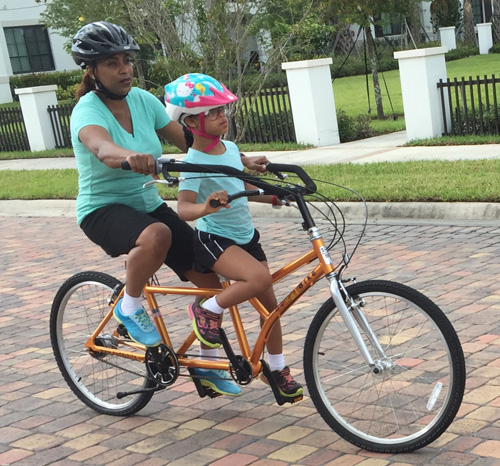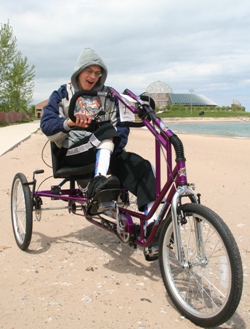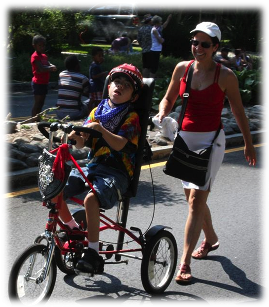Adaptive Cycling
Cycling is a fun way to enjoy the outdoors while getting a workout. Para-cycling (or Paracycling) is the sport of cycling, adapted for cyclists who have various disabilities. People with disabilities can enjoy para-cycling with cycles that fit their needs. In some cases, parents may need to consult their primary care doctor/medical home or a physical therapist for help choosing a cycle (such as with a child who wants a bike or trike for a present, but the family doesn't know what to purchase).
Para-cycling can be done for fun and fitness. There are local riding groups and worldwide teams available for cyclists of all skill levels.
Types of Adaptive Cycles
The Tandem Cycle

- Tandem cycles allow a
visually impaired person to ride with a sighted person.
- The visually-impaired person (as the Stoker) rides on the back seat.
- The person with vision (Captain) rides on the front seat and drives the cycle.
- The team learns to coordinate pedaling, shifting gears, and driving together.
- Tandem cycle riders should
take care to find a tandem cycle that fits their size.
- Many upright tandem cycles are built for small riders to sit in the rear/stoker seat.
- Tandem cycles with recumbent (reclining) seats and more wheels are also a choice.
- This type of cycle lowers the chance of falls and the need for balancing. See the Wikipedia Tandem Bicycle page for more information.
Handcycles
- These cycles are often recumbent (reclining) cycles, and the rider sits lower to the ground.
- For more information, see the Wikipedia Handcycle page.
Tricycles


- Tricycles are available in both recumbent and upright styles.
- See the Wikipedia Tricycle page for further information.
Bicycles
Getting Started
Cycling puts the rider at risk for getting hurt. The rider’s primary care doctor should help plan an exercise routine and urge proper safety equipment, including helmet, gloves, elbow, and knee pads. [American: 2001] [Van: 2012]
Cyclists should be checked for discomfort by a physical therapist or mobility expert as a result of incorrect fit. Injuries and pressure wounds can happen on the hands, knees, elbows, feet, back, sacrum, and any touch point for prosthetic devices.
Many cyclists will enjoy riding for fun and fitness, but there are also various levels of competitive cycling. Medical records are usually needed as the cyclist applies to take part in competitions.
The cyclist is usually grouped by the type of cycle to be used and the severity of their health care need. An example of the classifications can be found at Para-cycling Classification.
Use and Care
For recreational use, the cycle should be maintained by checking the chain, hardware, tire pressure and brakes before each ride. For competitive use, help with this kind of care may come from the team sponsor.
Funding and Costs
Custom cycles need to be purchased through specialized stores. Prices differ and health plans do not often cover the cost of the cycle. Groups that have recreational opportunities for people with disabilities may offer scholarships or discounted rates for use of equipment.
Resources
Information & Support
For Parents and Patients
U.S. Blind Tandem Cycling Connection
Provides information for individuals who are visually impaired or blind and are interested in getting into competitive cycling.
Orange County Bike Camp
Video describing the Orange County Bike Camp in California. Look for camps like this in your area.
Paralympian Cyclists Train
YouTube video of Paralympian cyclists training for world championships. Inspirational video for those who would like to compete.
UCI Introduction to Para-Cycling
YouTube video that explains the classifications for Paralympian cyclists.
Services for Patients & Families Nationwide (NW)
| Service Categories | # of providers* in: | NW | Partner states (4) (show) | | NM | NV | RI | UT | |
|---|---|---|---|---|---|---|---|---|---|
| Adaptive Sports | 8 | 21 | 16 | 26 | 50 | ||||
For services not listed above, browse our Services categories or search our database.
* number of provider listings may vary by how states categorize services, whether providers are listed by organization or individual, how services are organized in the state, and other factors; Nationwide (NW) providers are generally limited to web-based services, provider locator services, and organizations that serve children from across the nation.
Authors & Reviewers
| Author: | Alfred N. Romeo, RN, PhD |
| Reviewer: | Tina Persels |
Page Bibliography
American Academy of Pediatrics.
Bicycle helmets.
Pediatrics.
2001;108(4):1030-2.
PubMed abstract
Van de Vliet P.
Paralympic athlete's health.
Br J Sports Med.
2012;46(7):458-9.
PubMed abstract

